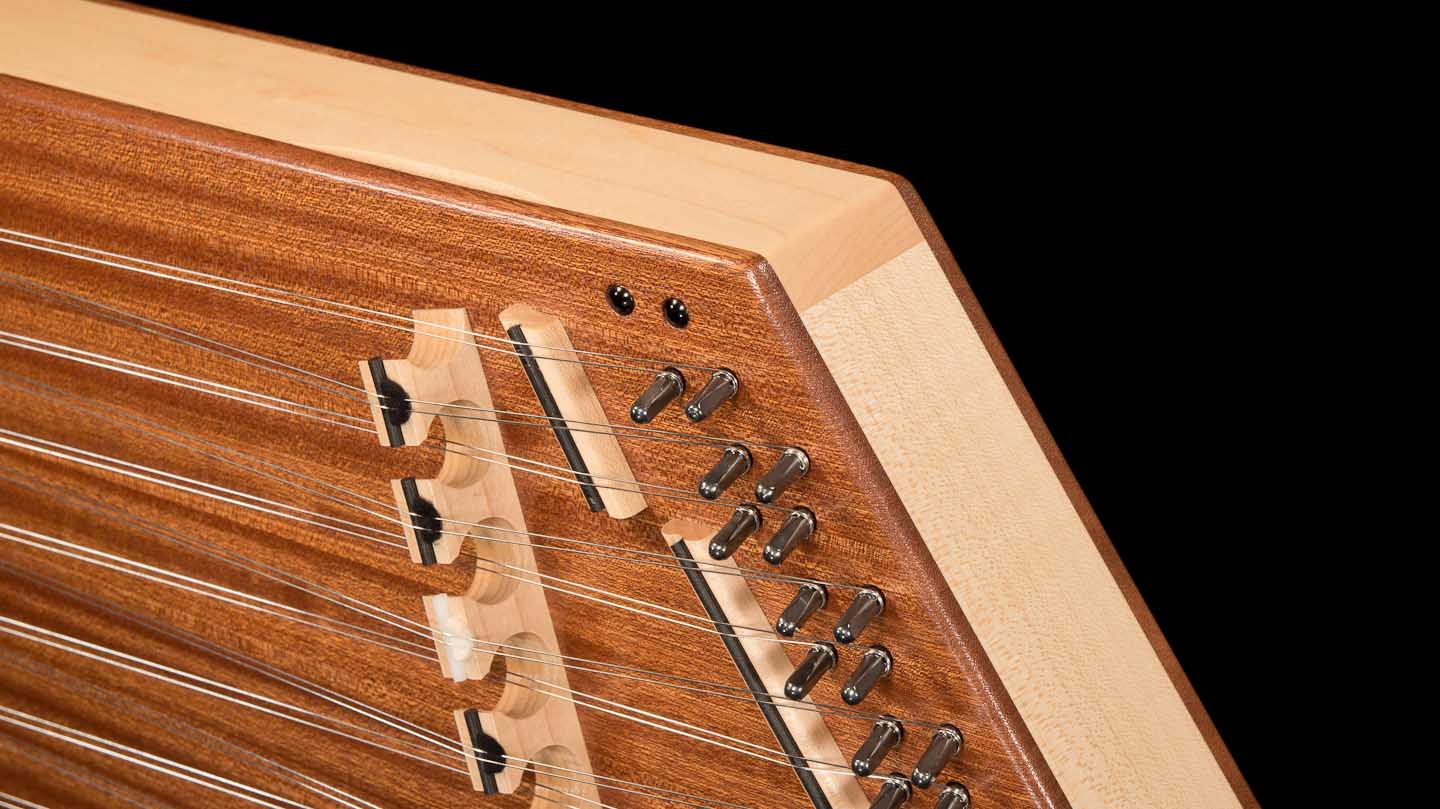Several of us are away at the Somerset Folk Harp Festival, and we may not be able to respond to emails and phone calls as quickly as usual. Thank you for your patience!
This page is designed to help you understand some of the basic features that differentiate each of our dulcimer models. At the top is our dulcimer finder, which you can use to filter by price range and different types of dulcimer features. If you're not sure what any of these features mean, or why they might be important, there is further explanation below. Click here to jump to the explanation.









Hammered dulcimer sizes are often described by the number of notes on each bridge. For example, a 16/15 dulcimer has 16 courses of strings on the treble bridge and 15 courses on the bass bridge, which translates to about 3 octaves of overall range. Most basic dulcimers have two bridges - a treble bridge and a bass bridge - but some instruments have a third bridge, often on the left-hand side, that extends the range lower than the bass bridge. We call this one the super bass bridge, and it's represented by a third number, as in 16/15/8.
Sometimes you hear dulcimers with a super bass bridge referred to as "extended range" because adding a third bridge can be a way to add more low notes without increasing the overall size of the body. Our D550 and D650 are examples of extended range dulcimers. Other dulcimers with three bridges might be called compact, if the purpose of the third bridge is to allow a rearrangement of notes that means the same range can be squeezed onto a smaller body. Our D300 is an example of this; it has the same range as our D500, but the body is a few inches shorter.
Because of the different possible bridge arrangements, you can have two dulcimers with the same body size but different ranges, or two dulcimers with the same range and different body sizes. Here are what our small, medium, and large body sizes look like relative to a 5'9" person:



One of the major factors in a dulcimer’s price is the material that the soundboard and back are made of. Our less expensive models have soundboards and backs made of laminated Finland birch, which is basically plywood (but the highest grade available), and comes in ready-to-cut sheet form. This saves a lot of time over solid wood soundboards, which come to us in the form of 2-inch thick sapele slabs that go through many steps of milling, gluing and sanding before becoming part of a dulcimer.
Laminated soundboards can sound really lovely, but there’s just a little extra of everything with a solid wood instrument – depth of tone, clarity, resonance – and a solid-wood instrument will also develop its own unique voice as it ages. One item to note is that hammered dulcimers with solid wood soundboards, like fine guitars and violins, require some attention to be paid to their environment in order to protect them from cracking or warping. Laminated soundboards, on the other hand, are quite impervious to these environmental extremes.
Even among solid wood dulcimers, there can be price differences related to other parts of the design and construction. For example, our Chromatic Series instruments have a more complex internal bracing system that produces a somewhat deeper and more lush sound than our other solid wood models. They also incorporate some extra woodworking details like binding and purfling around the edges, which add to the price.


This is often a difficult decision to make when you’re new to the dulcimer world! Generally, chromatic dulcimers are more complex and thus more expensive than dulcimers with traditional tuning, so sometimes your budget makes this decision for you. If you’re wavering on the edge, one way to approach the question is to consider what kind of music you think you’d like to play.
Traditional fifth-interval tuning works really well for diatonic music, such as fiddle tunes, Celtic music, old-time, hymns, and certain pop songs. (Diatonic means all the notes are in one major scale, like having just the white keys on a piano.) Traditionally-tuned dulcimers do have the capability for a few chromatic notes, depending on what key you’re playing in, but you won’t have all the sharps and flats and you won’t be able to easily play in keys outside of F, C, G, D, A and E.
If you want to play music that has a lot of sharps and flats or switches keys a lot, such as jazz, blues or classical, or if you need to be able to play hymns with your church group in the key of E-flat, you may want to choose a chromatic instrument so that you have the full capability to play in any key. A fifth-interval chromatic dulcimer is very similar to the standard traditional tuning, but fills in the missing chromatic notes via extra bridges or by making small substitutions where the standard tuning would have repeated notes. Though the chromatic fifth-interval tuning is generally more expensive, it is just as easy for a beginner to learn on as the standard fifth-interval tuning.
The other fully chromatic option is piano dulcimer tuning, which is laid out in a more linear fashion, with black and white markers mirroring the black and white keys on a piano. It can be a less expensive way to acquire full chromatic capability, but it's not commonly taught or arranged for, so you will be more or less on your own for learning how to play. This style is often appealing to players coming from a background in other keyboard instruments.
There’s more information about how to decide between the different tuning schemes on the Strings & Tuning Schemes page.


